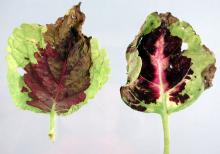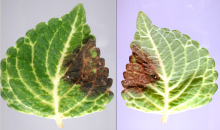See:
Basil, Sweet (Ocimum basilicum) - Downy Mildew
Cause The fungus Peronospora belbahrii that is similar to but distinct from P. lamii. The disease was found in Oregon in 2007 and 2008, generally in April. It affects newly expanding young leaves. Infection and sporulation occur readily from 59°F to 68°F but are reduced above 77°F. Extended periods of high relative humidity favor disease development. More sporangia can be found in the greenhouse air when long periods of high humidity are followed by low humidity midday. Infections will become inactive or latent once temperatures rise above 77°F and plants may appear healthy. Once conditions become cool and moist the pathogen can resume growth inside the plant.
The cultivars Florida Rustic Orange, Aurora Peach, Aurora Mocha, Fairway Mosaic, Florida Sun Jade, and New Orleans Red were susceptible while the cultivars Florida Sun Rose and Lava were resistant. Additional highly resistant cultivars include Dark Star, Twist of Lime, Henna, Bone Fish, Under the Sea Electric Coral, Under the Sea Lime Shrimp, Burgundy Lace, Cranberry Bog, and The Whirlpool.
Symptoms Infected foliage is chlorotic, distorted (inward curling and twisting of leaves), and stunted, usually turning brown and necrotic. Foliage infection results in defoliation and death of young seedlings. The undersides of leaves may develop an extensive violet-brown growth under high humidity prior to any signs of necrosis. On larger plants the lower older leaves fall off first leaving a tuft of newer leaves near the top of shoots.
Cultural control Regular scouting, especially the undersides of leaves, and quick removal of infected plants is critical to overall production.
- Grow resistant cultivars.
- Inspect new plugs and plants for signs of this disease.
- Remove and destroy infected leaves and/or plants.
- Grow in dry conditions where leaves are not wet for extended periods of time.
- Increased plant spacing will help air circulation and shorted leaf wetness periods.
- Rotate plant beds each year in the landscape.
Chemical control Best when applied prior to disease development. Rotate fungicides from different groups that have a different mode of action for resistance management.
- Adorn at 1 to 4 fl oz/100 gal water plus another fungicide. Drench rate is based on pot diameter. Group 43 fungicide. 12-hr reentry.
- Aliette at 1 to 2 lb/100 gal water. Try on a few plants before using on a large scale. Do not use with adjuvants. Group P7 fungicide. 24-hr reentry.
- Compass 50 WDG at 2 to 4 oz/100 gal water. Do not use organosilicate additives. Group 11 fungicide. 12-hr reentry.
- Disarm 480 SC at 1 to 4 fl oz/100 gal water. Group 11 fungicide. 12-hr reentry.
- Fenstop at 7 fl oz/100 gal water. For greenhouse use only. Group 11 fungicide. 12-hr reentry.
- Heritage at 2 to 4 oz/100 gal water plus a non-silicone-based wetter sticker. Group 11 fungicide. 4-hr reentry.
- Micora at 4 to 8 fl oz/100 gal water. Group 40 fungicide. 4-hr reentry.
- Monterey Garden Phos at 0.5 to 1.1 fl oz/gal water as a foliar spray. Also labeled for soil drench, see label for details. Group P7 fungicide. H
- Mural at 4 to 7 oz/100 gal water. Group 7 + 11 fungicide. 12-hr reentry.
- Orkestra at 8 to 10 fl oz/100 gal water. Group 7 + 11 fungicide. 12-hr reentry.
- Orvego at 14 fl oz/100 gal water. Group 40 + 45 fungicide. 12-hr reentry.
- OxiPhos at 1.3 to 4 quarts/100 gal water as a foliar spray. Group P7 fungicide. 4-hr reentry.
- Phyton 27 at 1.5 to 3 fl oz/10 gal water. Group M1 fungicide. 48-hr reentry.
- Segovis at 0.6 to 3.2 fl oz/100 gal water plus another fungicide for foliar application or 1 to 3.2 fl oz for drench applications. Group 49 fungicide. 4-hr reentry.
- Segway SC at 2.1 to 3.5 fl oz/100 gal water. Drench rate is based on pot diameter. Group 21 fungicide. 12-hr reentry.
- Stature SC at 6.12 to 12.25 fl oz/100 gal water. Group 40 fungicide. 12-hr reentry.
- Subdue MAXX at 0.13 to 0.25 fl oz/100 gal water as a seeding drench or at 0.5 to 1 fl oz/100 gal water plus another fungicide as a foliar spray. Group 4 fungicide. 48-hr reentry. No restrictions on reentry when used as a soil drench.
References Daughtrey, M.L., Holcomb, G.E., Eshenaur, B., Palm, M.E., Belbahri L., and Lefort F. 2006. First report of downy mildew on greenhouse and landscape coleus caused by a Peronospora sp. in Louisiana and New York. Plant Disease 90:1111.
Thines, M., Telle, S., Ploch, S., and Runge, F. 2009. Identity of the downy mildew pathogens of basil, coleus, and sage with implications for quarantine measures. Mycological Research 113:532-540.



